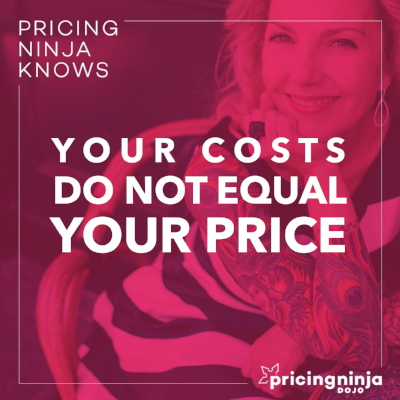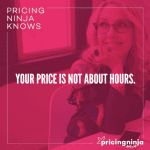Why Cost-Based Pricing Doesn’t Work, and a Better Formula to Use Instead
A new client’s been in business for a while: she’s booked-up, her customers are happy, her Yelp reviews are stellar. And she’s exhausted and a bit puzzled. Why oh why does all this success feel like such a struggle? & Why oh why is there no money in the bank? Is this just how it’s gonna be forever: everyone else gets what they want, and she’s just gonna keep struggling along?
Oh, heck no.
Enter Pricing Ninja.
Working together one-on-one to examine how she’s been pricing to date, we uncovered a fatal flaw, something so many entrepreneurs do starting out. [Because honestly who knows how to price, really, unless someone’s shown you how?]
This fatal flaw: adding up your costs, then just adding some amount on top of that, to arrive at your price.
Though it might seem logical, cost-based pricing manages to result in a price that’s way too low 99.99% of the time. A price that’s designed to keep a person struggling – busy, yes, but struggling.
Because we forget the essential thing: our price is not about our costs, but about the VALUE of the service from the client’s perspective.

The selling price formula is not about costs; it’s about value.
Of course it’s important to know your costs. Critical, even! But when you’re pricing, know them and then set them aside so you can focus on the outcome from the client’s perspective. Because that’s the part that really matters. That outcome? That’s what your price is about — > not the number of hours it takes you, not the cost of your subs or materials.
We know this in our bones when we’re buying things ourselves. Otherwise, how do we explain paying $170 for a pair of jeans, $60 for a bottle of wine, $250 for a pair of shoes? Maybe you’re not paying those prices (I’m more of a $60/jeans kind of person myself), but the example still holds true. Price is so much more than time & materials. It’s about so much more than math.
Price is about how that thing / experience makes you feel.
When you’re deciding how to price a product, ask yourself what do your clients get from working with you? How’s the experience? What is their state before they start with you, and what is it after? All of those intangibles that you bring to the table, that’s the really good stuff, the stuff that invariably gets left out of the equation when you just add up your costs and tack something on top.
Price for the good stuff, people. That right there has the potential to change everything.



